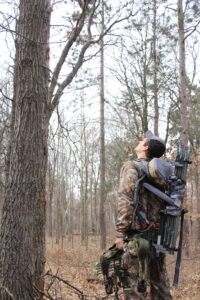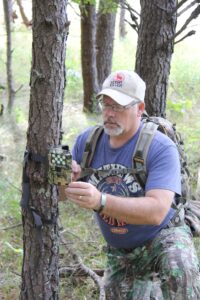Taking a bowhunting road trip can be intimidating. What should I take and what should I leave home? Here’s a crash course in making sure you have the right stuff and how to avoid loading the truck with things you won’t need.
By Bernie Barringer
On my first hunt to North Dakota I thought I had things pretty well dialed in before I left home. I had spent some time looking at several areas on Google Earth. I’d spoken with the biologist for one piece of state land and he confirmed that a cornfield planted in the food plot had a good number of deer using it. They intended to leave the corn in the field until spring. The area looked terrific with lots of trees and potential bedding areas near the food plot.
I was so confident when I arrived that I carried a treestand and sticks out to the food plot when I went out to scout it. There was find plenty of deer sign around the food plot, but there wasn’t a tree in sight that I could hang my stand in. There were small trees, crooked trees, tall skinny trees and cottonwoods too big to get my stick’s straps around. I had to carry all that stuff the ¾-mile back to the truck and start over.
I’ve seen similar situations in the western whitetail states too. The equipment that works perfectly in the hardwood forests I had hunted previously was mostly useless in that habitat.
Stands, Sticks, Ladders, Terrain and Trees
Hunting the way I do, long walks with quite a bit of equipment are the norm. There are places where a climbing stand is the perfect tool for the job to move in on a deer and get up quickly. But if you take a climbing stand on a hunt to North Dakota, Montana or Nebraska, you’ll most likely never take it out of the truck. You will need a ground blind and some ladder stands. I have learned that the equipment I take needs to match the hunting style and the terrain.
Throughout most of the hunting situations you’ll face, a climbing stand will have some use but I primarily use a hang-on stand and portable climbing sticks. I prefer the stackable sticks like the Hawk Helium models because they are stackable, lighter and much easier to carry through the woods.
There are trade-offs between comfort and weight. I tend to spend long hours in stands and I lean towards comfort over weight. It takes maybe an hour to walk the stand in to the site, in which I am working harder with a heavier stand, but I may sit in that stand 20-30 hours or more over the course of the hunt. I’ll opt for the hours of comfort every time. A comfortable stand helps me stay silent, motionless and focused.
Ground Blinds
I can’t remember the last time I went on a hunt without a ground blind in the truck and I use it quite a bit. Ground blinds do present some issues that must be overcome. Whitetails are notoriously fidgety around anything that just shows up in their living room. I try hard to hide the blind in some sort of cover, or even place it beside some piece of farm machinery or bush, or maybe tuck it between a couple cedars. Then brush it in well with natural vegetation to blend it in.
There are times and places where a blind is the only option you have. Once you put it out, leave it out. The more times the deer see it the sooner they will start to ignore it.
Inside my ground blind I have three important things that make a difference for me. The first is something to hold my bow in position so I can grab it quickly.
The second is a comfortable chair. Give me a good chair in which I can sit up high and straight. Stay away from those short, triangular torture chairs. I have a chair with a little table which folds out of the side of it, which leads me to the third important thing.
You need a place with

in reach to put some important tools and gadgets. During the day I am using my phone, a rangefinder, a book, etc. In each case, you need a place within reach where you can quietly and quickly lay these things down to get ready for a shot. That little table attached to the side of my chair works perfectly for this.
How Many Stands Do You Need?
During a week-long hunt I will have an average of three stands in the woods at any given time. I’ve had as many as five but that’s rare and in fact, I usually only take 4-5 stands with me. The type of stands I have in the truck depend on the terrain and trees as I mentioned earlier. Heading to North Dakota or Montana, I’ll probably have two ladders, a hang-on and two ground blinds. Where hardwoods dominate the habitat, such as Iowa, Kansas, Ohio or Missouri, I will usually have four hang-ons, a climber and a ground blind.
Once you put your tag on that deer, you now have to gather up all your gear. It’s a good idea to keep that thought in mind as you spread your gear across the landscape. When I get my buck I am usually in a hurry to leave. It might be because I am more than ready to get home to my family, or it might be that I really want to get to the next state because the rut is in full swing. Either way, while I am putting gear in the woods, the thought of how fast I can get it out is on my mind.
Accessories
I used to take both a doe decoy and a buck decoy along but now I save space and I mostly only use the buck. I have not had many positive experiences using a doe decoy alone, in fact I have probably had more negative reactions to the doe decoy than positive. However, I use a buck decoy quite a bit and I’m learning more and more all the time how to use it properly. I’ve carried that thing back into some pretty inaccessible spots and I will continue to do so.
You’ll need to have some method of getting the deer out. In the back of my truck I usually have a 2-wheeled deer cart and a plastic sled. Lately I have fallen in love with the Crawler deer cart and I use it more and more.
Storing and Accessing Your Equipment
Sometimes when I get home from a hunting trip, it looks like someone swallowed the hunting department at a Cabela’s and puked it up in the back of my truck. It never starts out that way, but it seems to end up that way.
Since I carry a lot of gear, I like to load it into totes based on how it will be used. Treestand stuff goes in one tote; that includes things like hooks, bow hangers, camera arms, extra straps, etc. I label the tote “STANDS.” Things like scents and lures, Scent Killer spray, scrape drippers and the like go into another tote labeled “SCENTS.” Another is labeled “TRAIL CAMERAS.” It includes cameras, extra batteries, security boxes, padlocks and the like.
Meat processing equipment goes in yet another labeled tote. This includes knives, wrapping paper, tape, extra gutting gloves, bone saw, a cutting board, markers, etc. This usually goes into the front of the truck bed with the coolers because I won’t need it every day.
Another tote includes cold weather gear such as extra gloves and hats, full face mask, balaclava, etc. I may or may not use the contents of that tote depending on the weather but I like to have it along in case the weather takes a turn for the worse.
Clothing
Today’s weather forecasts are much more accurate than ever before, but the forecasters can still get it wrong. I tend to over-pack clothing and usually that’s a good thing. During a couple weeks time in 2-3 states, you might be sitting in a treestand in temperatures from 20-70 degrees. That takes a wide variety of clothing. I tend to take things I can layer, which helps. I also try to wear different clothing for scouting and checking trail cameras whenever practical because I can work up a sweat while hustling around doing these walks.
It’s hard to overstate the value of a good set of quality rain gear. I have yet to find a set of rain gear that will keep me dry all day during a steady rain, but some of the better ones come close. I have two sets of merino wool base layers.
On long trips, doing laundry might be necessary. I carry some Scent Killer laundry detergent with me and use it to wash clothes in a Laundromat if needed. I hate going to town to do laundry when I could be doing other, seemingly more productive hunting-related tasks, but keeping clean and keeping my scent and body odor to a minimum is important to me so I tend to wash clothes more than some people might.
I carry three pairs of boots. Two are rubber boots, one without insulation and one with 1200 grams of Thinsulate for cold weather. I also use a pair of good leather hiking boots which I wear to and from the hunts and also at times when I have long walks that won’t involve any water crossing.
This article is condensed from one chapter in Bernie Barringer’s revealing book The Freelance Bowhunter: DIY strategies for the traveling whitetail hunter. The book can be purchased for $19.99 plus $3.99 S&H at www.bernieoutdoors.com or by sending a check to Bernie Barringer Outdoors, 9969 50th Ave, Brainerd, MN 56401.
What’s in Your Backpack?
There are a few things that I would never want to do without on a trip. One of them is a backpack with a few necessary items. Some of these I use every day and some of them are there for emergencies. The things I use most every day are deer call, rattling antlers, wind puffer bottle, gloves, warm hat, flashlight, headlight, binoculars and rangefinder. Other things that may come in handy also have a place in my pack such as toilet paper and wet wipes, a lighter or fire starter, deer scents, flagging tape, GPS, hand-warmers, gutting gloves, field dressing knife and extra SD cards for trail cameras. I tuck a plastic garbage bag into the corner of the pack somewhere so I can pull it out and use it to cover the pack if it starts to rain.
I never leave the truck without a camera. I take a lot of photos and I video my hunts whenever it is practical to do so. I’m sure you can see that my backpack is pretty full most of the time. I also like a backpack with straps on the back so I can attach a coat or a set of bib overalls to put on once I get to the stand.
